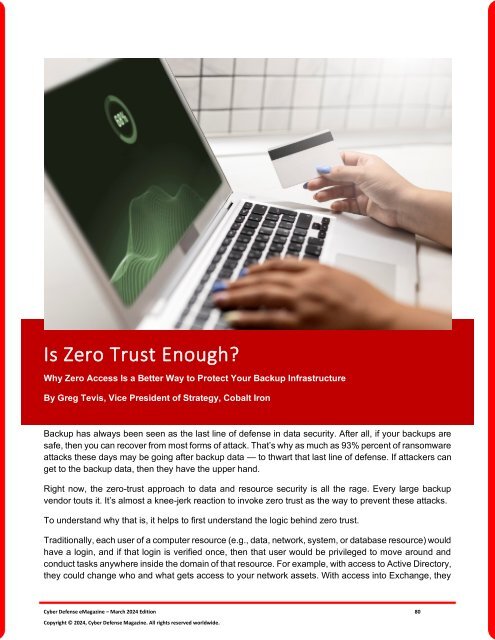The Cyber Defense eMagazine March Edition for 2024
Cyber Defense eMagazine March Edition for 2024 #CDM #CYBERDEFENSEMAG @CyberDefenseMag by @Miliefsky a world-renowned cyber security expert and the Publisher of Cyber Defense Magazine as part of the Cyber Defense Media Group as well as Yan Ross, Editor-in-Chief and many more writers, partners and supporters who make this an awesome publication! 225 page March Edition fully packed with some of our best content. Thank you all and to our readers! OSINT ROCKS! #CDM #CDMG #OSINT #CYBERSECURITY #INFOSEC #BEST #PRACTICES #TIPS #TECHNIQUES
Cyber Defense eMagazine March Edition for 2024 #CDM #CYBERDEFENSEMAG @CyberDefenseMag by @Miliefsky a world-renowned cyber security expert and the Publisher of Cyber Defense Magazine as part of the Cyber Defense Media Group as well as Yan Ross, Editor-in-Chief and many more writers, partners and supporters who make this an awesome publication! 225 page March Edition fully packed with some of our best content. Thank you all and to our readers! OSINT ROCKS! #CDM #CDMG #OSINT #CYBERSECURITY #INFOSEC #BEST #PRACTICES #TIPS #TECHNIQUES
Create successful ePaper yourself
Turn your PDF publications into a flip-book with our unique Google optimized e-Paper software.
Is Zero Trust Enough?<br />
Why Zero Access Is a Better Way to Protect Your Backup Infrastructure<br />
By Greg Tevis, Vice President of Strategy, Cobalt Iron<br />
Backup has always been seen as the last line of defense in data security. After all, if your backups are<br />
safe, then you can recover from most <strong>for</strong>ms of attack. That’s why as much as 93% percent of ransomware<br />
attacks these days may be going after backup data — to thwart that last line of defense. If attackers can<br />
get to the backup data, then they have the upper hand.<br />
Right now, the zero-trust approach to data and resource security is all the rage. Every large backup<br />
vendor touts it. It’s almost a knee-jerk reaction to invoke zero trust as the way to prevent these attacks.<br />
To understand why that is, it helps to first understand the logic behind zero trust.<br />
Traditionally, each user of a computer resource (e.g., data, network, system, or database resource) would<br />
have a login, and if that login is verified once, then that user would be privileged to move around and<br />
conduct tasks anywhere inside the domain of that resource. For example, with access to Active Directory,<br />
they could change who and what gets access to your network assets. With access into Exchange, they<br />
<strong>Cyber</strong> <strong>Defense</strong> <strong>eMagazine</strong> – <strong>March</strong> <strong>2024</strong> <strong>Edition</strong> 80<br />
Copyright © <strong>2024</strong>, <strong>Cyber</strong> <strong>Defense</strong> Magazine. All rights reserved worldwide.

















